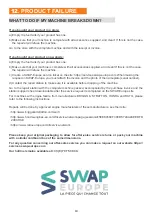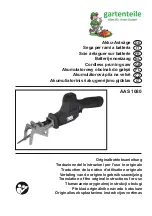
EN
also make exposed metal parts of the power tool "live" and could give the operator an electric
shock.
f)
When ripping, always use a rip fence or straight edge guide.
This improves the accuracy of
cut and reduces the chance of blade binding.
g)
Always use blades with correct size and shape (diamond versus round) of arbour holes.
Blades that do not match the mounting hardware of the saw will run off-centre, causing loss
of control.
h)
Never use damaged or incorrect blade washers or bolt.
The blade washers and bolt were
specially designed for your saw, for optimum performance and safety of operation.
Further safety instructions for all saws
Kickback causes and related warnings
– kickback is a sudden reaction to a pinched, jammed or misaligned saw blade, causing an
uncontrolled saw to lift up and out of the workpiece toward the operator;
– when the blade is pinched or jammed tightly by the kerf closing down, the blade stalls and
the motor reaction drives the unit rapidly back toward the operator;
– if the blade becomes twisted or misaligned in the cut, the teeth at the back edge of the
blade can dig into the top surface of the wood causing the blade to climb out of the kerf and
jump back toward the operator.
Kickback is the result of saw misuse and/or incorrect operating procedures or conditions and
can be avoided by taking proper precautions as given below.
a)
Maintain a firm grip with both hands on the saw and position your arms to resist
kickback forces. Position your body to either side of the blade, but not in line with the blade.
Kickback could cause the saw to jump backwards, but kickback forces can be controlled by the
operator, if proper precautions are taken.
NOTE For
circular saws
with a maximum blade diameter of 140 mm or smaller, the words "with both hands" do not
apply.
b)
When blade is binding, or when interrupting a cut for any reason, release the trigger and
hold the saw motionless in the material until the blade comes to a complete stop. Never
attempt to remove the saw from the work or pull the saw backward while the blade is in
motion or kickback may occur.
Investigate and take corrective actions to eliminate the cause
of blade binding.
c)
When restarting a saw in the workpiece, centre the saw blade in the kerf so that the saw
teeth are not engaged into the material.
If a saw blade binds, it may walk up or kickback
from the workpiece as the saw is restarted.
06






































